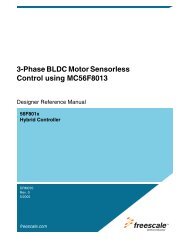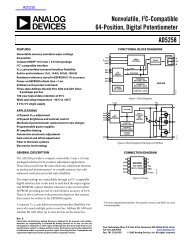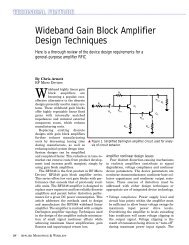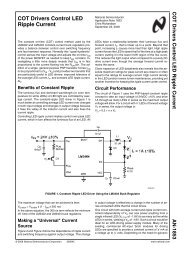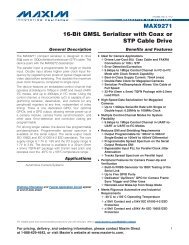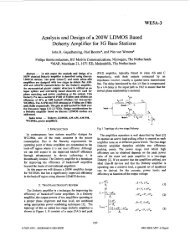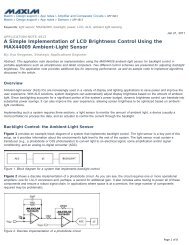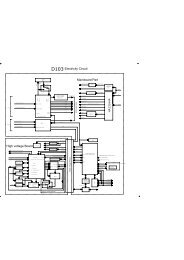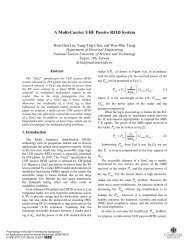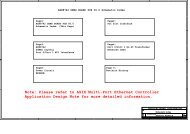MAX9272 28-Bit GMSL Deserializer for Coax or STP Cable
MAX9272 28-Bit GMSL Deserializer for Coax or STP Cable
MAX9272 28-Bit GMSL Deserializer for Coax or STP Cable
Create successful ePaper yourself
Turn your PDF publications into a flip-book with our unique Google optimized e-Paper software.
<strong>MAX9272</strong><br />
<strong>28</strong>-<strong>Bit</strong> <strong>GMSL</strong> <strong>Deserializer</strong> <strong>f<strong>or</strong></strong> <strong>Coax</strong> <strong>or</strong> <strong>STP</strong> <strong>Cable</strong><br />
Additional Err<strong>or</strong> Detection and C<strong>or</strong>rection<br />
In default mode (additional err<strong>or</strong> detection and c<strong>or</strong>rection<br />
disabled), data encoding/decoding is the same as<br />
in previous <strong>GMSL</strong> serializers/deserializers (parity only).<br />
At the serializer, the parallel input w<strong>or</strong>d is scrambled and<br />
a parity bit is added. The scrambled w<strong>or</strong>d is divided into<br />
3 <strong>or</strong> 4 bytes (depending on the BWS setting), 8b/10b<br />
encoded, and then transmitted serially. At the deserializer,<br />
the same operations are per<strong>f<strong>or</strong></strong>med in reverse <strong>or</strong>der.<br />
The parity bit is used by the deserializer to find the w<strong>or</strong>d<br />
boundary and <strong>f<strong>or</strong></strong> err<strong>or</strong> detection. Err<strong>or</strong>s are counted in<br />
an err<strong>or</strong> counter register and an err<strong>or</strong> pin indicates err<strong>or</strong>s.<br />
The deserializer can use one of two additional err<strong>or</strong>detection/c<strong>or</strong>rection<br />
methods (selectable by register<br />
setting):<br />
1) 6-bit cyclic redundancy check<br />
2) 6-bit hamming code with 16-w<strong>or</strong>d interleaving<br />
Cyclic Redundancy Check (CRC)<br />
When CRC is enabled, the serializer adds 6 bits of CRC<br />
to the input data. This reduces the available bits in the<br />
input data w<strong>or</strong>d by 6, compared to the non-CRC case<br />
(see Table 2 <strong>f<strong>or</strong></strong> details). F<strong>or</strong> example, 16 bits are available<br />
<strong>f<strong>or</strong></strong> input data instead of 22 bits when BWS = 0, and<br />
24 bits instead of 30 bits when BWS = 1.<br />
The CRC generat<strong>or</strong> polynomial is x 6 + x + 1 (as used in<br />
the ITU-T G704 telecommunication standard).<br />
The parity bit is still added when CRC is enabled, because<br />
it is used <strong>f<strong>or</strong></strong> w<strong>or</strong>d-boundary detection. When CRC is<br />
enabled, each data w<strong>or</strong>d is scrambled and then the<br />
6-bit CRC and 1-bit parity are added be<strong>f<strong>or</strong></strong>e the 8b/10b<br />
encoding.<br />
At the deserializer, the CRC code is recalculated. If the<br />
recalculated CRC code does not match the received<br />
CRC code, an err<strong>or</strong> is flagged. This CRC err<strong>or</strong> is rep<strong>or</strong>ted<br />
to the err<strong>or</strong> counter.<br />
Hamming Code<br />
Hamming code is a simple and effective err<strong>or</strong>-c<strong>or</strong>rection<br />
code to detect and/<strong>or</strong> c<strong>or</strong>rect err<strong>or</strong>s. The <strong>MAX9272</strong><br />
deserializer (when used with the MAX9271/MAX9273<br />
<strong>GMSL</strong> serializers) uses a single-err<strong>or</strong> c<strong>or</strong>rection/doubleerr<strong>or</strong><br />
detection per pixel hamming-code scheme.<br />
The deserializer uses data interleaving <strong>f<strong>or</strong></strong> burst err<strong>or</strong><br />
tolerance. Burst err<strong>or</strong>s up to 11 consecutive bits on the<br />
serial link are c<strong>or</strong>rected and burst err<strong>or</strong>s up to 31 consecutive<br />
bits are detected.<br />
Hamming code adds overhead similar to CRC. See Table 2<br />
<strong>f<strong>or</strong></strong> details regarding the available input w<strong>or</strong>d size.<br />
HS/VS Encoding and/<strong>or</strong> Tracking<br />
HS/VS encoding by a <strong>GMSL</strong> serializer allows h<strong>or</strong>izontal<br />
and vertical synchronization signals to be transmitted<br />
while conserving pixel data bandwidth. With HS/<br />
VS encoding enabled, 10-bit pixel data with a clock up<br />
to 100MHz can be transmitted using one video pixel of<br />
data per HS/VS transition versus 8-bit data with a clock<br />
up to 100MHz without HS/VS encoding. The deserializer<br />
per<strong>f<strong>or</strong></strong>ms HS/VS decoding, tracks the period of the HS/VS<br />
signals, and uses voting to filter HS/VS bit err<strong>or</strong>s. When<br />
using HS/VS encoding, use a minimum HS/VS low-pulse<br />
duration of two PCLKOUT cycles when DBL = 0 on the<br />
deserializer. When DBL = 1, use a minimum HS/VS lowpulse<br />
duration of five PCLKOUT cycles and a minimum<br />
high-pulse duration of two PCLKOUT cycles. When using<br />
hamming code with HS/VS encoding, do not send m<strong>or</strong>e<br />
than two transitions every 16 PCLKOUT cycles.<br />
When the serializer uses double-input mode (DBL = 1),<br />
the active duration, plus the blanking duration of HS <strong>or</strong> VS<br />
signals, should be an even number of PCLKOUT cycles.<br />
When DBL = 1 in the serializer and DBL = 0 in the deserializer,<br />
two pixel clock cycles of HS/VS at the serializer<br />
input are output at the HS0/VS0 and HS1/VS1 output of<br />
the deserializer in one cycle. The first cycle of HS/VS goes<br />
out of HS0/VS0 and the second cycle goes out of HS1/<br />
VS1. HS1 and VS1 are not used when HVEN = 0.<br />
If HS/VS tracking is used without HS/VS encoding, use<br />
DOUT0 <strong>f<strong>or</strong></strong> HSYNC and DOUT1 <strong>f<strong>or</strong></strong> VSYNC. In this case,<br />
if DBL values on the serializer/deserializer are different,<br />
set the UNEQDBL register bit in the deserializer to 1. If<br />
the serializer and deserializer have unequal DBL settings<br />
and HVEN = 0, then HS/VS inversion should only be used<br />
on the side that has DBL = 1. HS/VS encoding sends<br />
packets when HSYNC <strong>or</strong> VSYNC is low; use HS/VS inversion<br />
register bits if input HSYNC and VSYNC signals use<br />
an active-low convention in <strong>or</strong>der to send data packets<br />
during the inactive pixel clock periods.<br />
Serial Input<br />
The device can receive serial data from two kinds of<br />
cables: 100I twisted pair and 50I coax (contact the<br />
fact<strong>or</strong>y <strong>f<strong>or</strong></strong> devices compatible with 75I cables).<br />
<strong>Coax</strong>-Mode Splitter<br />
In coax mode, OUT+ and OUT- of the serializer are<br />
active. This enables use as a 1:2 splitter (Figure 29). In<br />
coax mode, connect OUT+ to IN+ of the deserializer.<br />
32


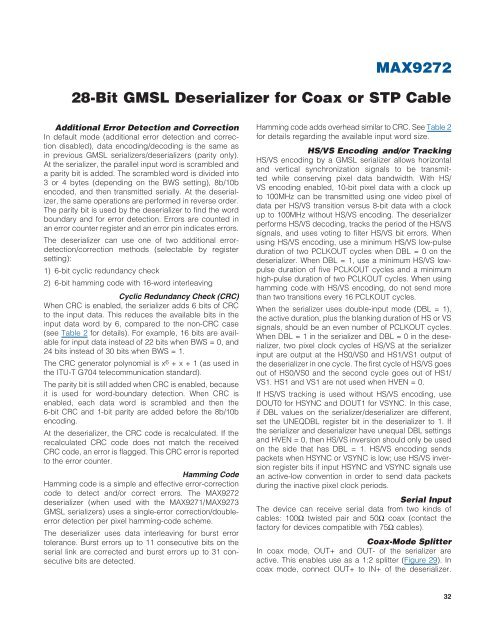
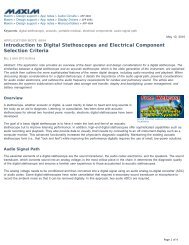
![P-CAD EDA - [Sheet1]](https://img.yumpu.com/49470492/1/190x115/p-cad-eda-sheet1.jpg?quality=85)
